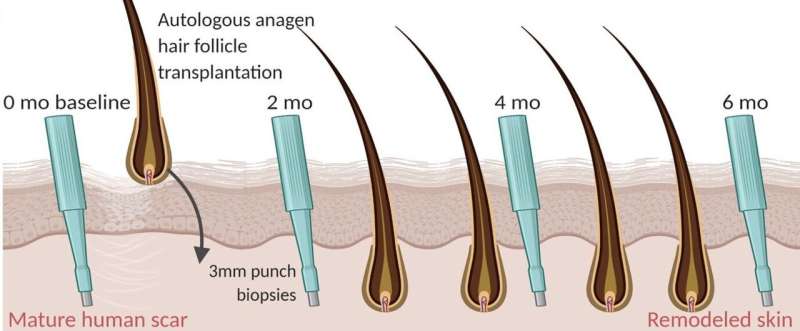This article has been reviewed according to Science X's editorial process and policies. Editors have highlighted the following attributes while ensuring the content's credibility:
fact-checked
trusted source
proofread
Scars mended using transplanted hair follicles in new study

In a new Imperial College London study involving three volunteers, skin scars began to behave more like uninjured skin after they were treated with hair follicle transplants. The scarred skin harbored new cells and blood vessels, remodeled collagen to restore healthy patterns, and even expressed genes found in healthy unscarred skin.
The findings could lead to better treatments for scarring both on the skin and inside the body, leading to hope for patients with extensive scarring, which can impair organ function and cause disability.
Lead author Dr. Claire Higgins, of Imperial's Department of Bioengineering, said, "After scarring, the skin never truly regains its pre-wound functions, and until now all efforts to remodel scars have yielded poor results. Our findings lay the foundation for exciting new therapies that can rejuvenate even mature scars and restore the function of healthy skin."
The research is published in npj Regenerative Medicine.
Hope in hair
Scar tissue in the skin lacks hair, sweat glands, blood vessels and nerves, which are vital for regulating body temperature and detecting pain and other sensations. Scarring can also impair movement as well as potentially cause discomfort and emotional distress.
Compared to scar tissue, healthy skin undergoes constant remodeling by the hair follicle. Hairy skin heals faster and scars less than non-hairy skin—and hair transplants had previously been shown to aid wound healing. Inspired by this, the researchers hypothesized that transplanting growing hair follicles into scar tissue might cause scars to remodel themselves.
To test their hypothesis, Imperial researchers worked with Dr. Francisco Jiménez, lead hair transplant surgeon at the Mediteknia Clinic and Associate Research Professor at University Fernando Pessoa Canarias, in Gran Canaria, Spain. They transplanted hair follicles into the mature scars on the scalps of three participants in 2017. The researchers selected the most common type of scar, called normotrophic scars, which usually form after surgery.
They took and microscope-imaged 3 mm-thick biopsies of the scars just before transplantation, and then again at two, four, and six months afterwards.
The researchers found that the follicles inspired profound architectural and genetic shifts in the scars towards a profile of healthy, uninjured skin.
Dr. Jiménez said, "Around 100 million people per year acquire scars in high-income countries alone, primarily as a result of surgeries. The global incidence of scars is much higher and includes extensive scarring formed after burn and traumatic injuries. Our work opens new avenues for treating scars and could even change our approach to preventing them."
Architects of skin
After transplantation, the follicles continued to produce hair and induced restoration across skin layers.
Scarring causes the outermost layer of skin—the epidermis—to thin out, leaving it vulnerable to tears. At six months post-transplant, the epidermis had doubled in thickness alongside increased cell growth, bringing it to around the same thickness as uninjured skin.
The next skin layer down, the dermis, is populated with connective tissue, blood vessels, sweat glands, nerves, and hair follicles. Scar maturation leaves the dermis with fewer cells and blood vessels, but after transplantation the number of cells had doubled at six months, and the number of vessels had reached nearly healthy-skin levels by four months. This demonstrated that the follicles inspired the growth of new cells and blood vessels in the scars, which are unable to do this unaided.
Scarring also increases the density of collagen fibers—a major structural protein in skin—which causes them to align such that scar tissue is stiffer than healthy tissue. The hair transplants reduced the density of the fibers, which allowed them to form a healthier "basket weave" pattern, reducing stiffness—a key factor in tears and discomfort.
The authors also found that after transplantation, the scars expressed 719 genes differently than before. Genes that promoted cell and blood vessel growth were expressed more, while genes that promoted scar-forming processes were expressed less.
Multi-pronged approach
The researchers are unsure precisely how the transplants facilitated such a change. In their study, the presence of a hair follicle in the scar was cosmetically acceptable as the scars were on the scalp. The team is now working to uncover the underlying mechanisms so they can develop therapies that remodel scar tissue towards healthy skin, without requiring transplantation of a hair follicle and growth of a hair fiber. They can then test their findings on non-hairy skin, or on organs like the heart, which can suffer scarring after heart attacks, and the liver, which can suffer scarring through fatty liver disease and cirrhosis.
Dr. Higgins said, "This work has obvious applications in restoring people's confidence, but our approach goes beyond the cosmetic as scar tissue can cause problems in all our organs.
"While current treatments for scars like growth factors focus on single contributors to scarring, our new approach tackles multiple aspects, as the hair follicle likely delivers multiple growth factors all at once that remodel scar tissue. This lends further support to the use of treatments like hair transplantation that alter the very architecture and genetic expression of scars to restore function."
More information: Anagen hair follicles transplanted into mature human scars remodel fibrotic tissue, npj Regenerative Medicine (2023). DOI: 10.1038/s41536-022-00270-3 , www.nature.com/articles/s41536-022-00270-3


















